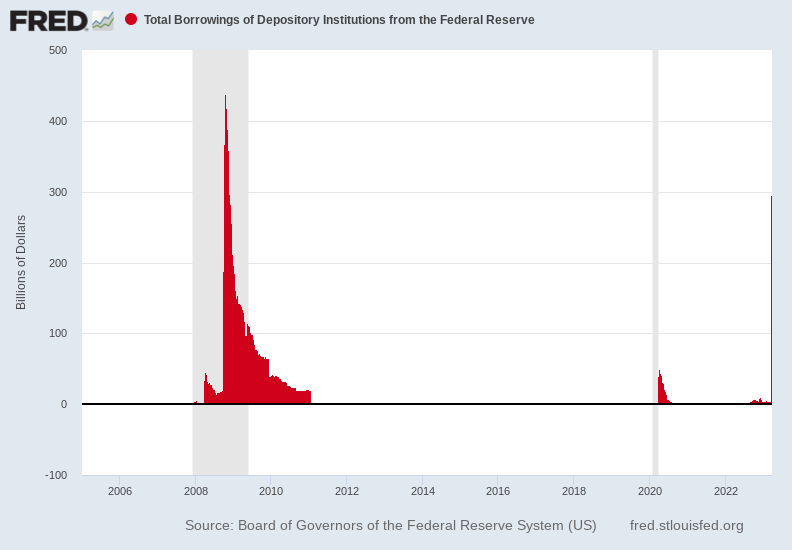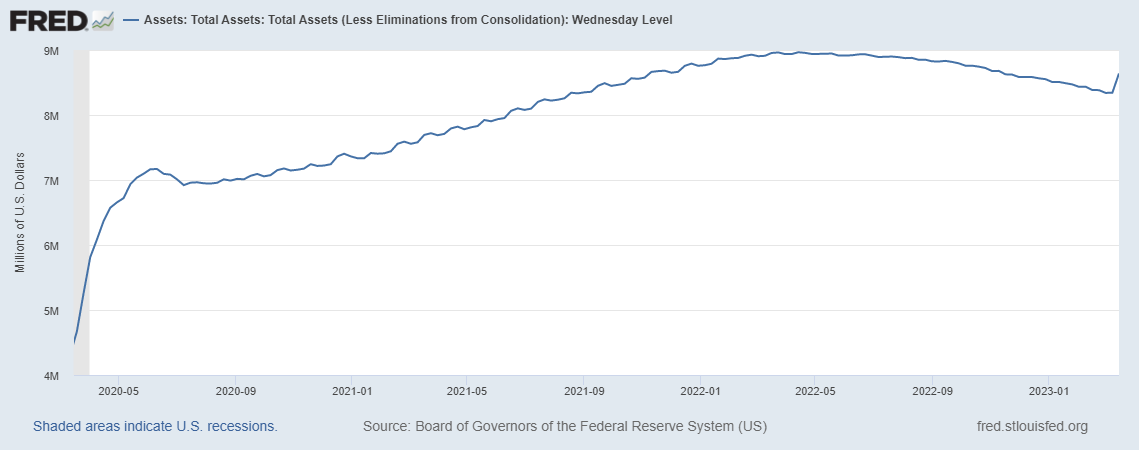A Shock To The System
“What was it Han Solo always said? ‘I got a bad feeling about this’...”
That was “Han Denning,” writing to Bonner Private Research members in yesterday’s weekly research note. We’ll get back to Mr. Denning’s cheerful prognostications in a moment... but first, let’s dive into the weekly market wrap.
Despite the jitters around the financial sector (and really, what’s a wave of major bank runs every now and then, eh? Eh?) major indices all turned in positive performances this week. The Dow Jones Industrial Average rose 0.4% in Friday’s session. The S&P 500 closed up 0.6% while the Nasdaq gained 0.3%.
The big three were all in the black for the week, notching gains of 0.4%, 1.4% and 1.6%, respectively.
Indeed, if you didn’t know the financial system was “majorly stressed out,” as the kids say, you could be forgiven for thinking all was well in the world. Of course, there’s the whole Credit Suisse “merger” (read: collapse)...and growing concerns on both sides of the Atlantic; around First Republic Bank on the US front, and German giant Deutsche Bank over in Europe. But markets appear more focused on asking What Will Jerome Do (WWJD?) than apprising such yawn-fests as “systemic risk.”
Still, it’s difficult to ignore the perils if you’re looking at gold’s shiny chart. At $2,000/oz, the Midas Metal has already taken out all time highs in Pound Sterling and Aussie Dollars this year. One gets the inkling a new ATH in Greenbacks can’t be far off...
Over in the crypto space, meanwhile, Bitcoin (BITCOMP) had something of a schizophrenic week, coughing up ~$2,000 on Wednesday alone... before dusting itself off to retake the $28,500 mark on Thursday... then fizzling somewhat into the weekend. It was last seen trading for around $27,500 per btc, up a eye-watering $11,000 year-to-date, or around +65%.
Over in the oil patch, a (WTI) barrel of the world’s preferred energy trades for just under $70.
But back to our man up in Laramie, Wyoming. What’s giving Mr. Denning a “bad feeling”...
I’m talking about the $300 billion spike in borrowing from the Federal Reserve this week by depository institutions (banks). And I’m talking about a $350 billion total increase in the use of the Fed’s liquidity and credit facilities.
These macro ‘factors’ are signs of massive stress in the financial system. This stress belies the comforting words of the financial authorities that everything is fine. They’re quick to tell us that today is nothing like 2008. The banking system is sound. The economy is resilient. The dollar is strong. Amen.
But in the 'inflate or die' worldview, this moment feels like the ER doctor breaking out the defibrillators and shouting 'clear.' Zap. Shock the heart of the system back to life.
(Source: US Federal Reserve)
Check out that thin red spike on the far right of the chart. Zap!
So… all’s not quiet on the western front, then?
Here’s Tom Dyson’s take on the situation, excerpted from his regular update to BPR members this past Wednesday...
The reason the banks are collapsing is because depositors – like Kate and I – have found higher interest rates (and more safety) in money markets and T-bills. So deposits are draining out of the banking system and pouring into the Fed’s reverse repo facility and government debt securities. It’s causing the banking system to wobble, especially at the edges.
The Fed’s 0.25% rate hike [Wednesday] will only put more energy into this trend.
This is just the beginning. Like there’s a big storm offshore, and we’ve just felt the first bands of rain and the first hurricane-strength gusts of wind. It’s going to be a big one. This chart shows the value of assets on the Fed’s balance sheet.
(Source: US Federal Reserve)
Some people are looking at this chart and thinking the recent inflection represents more stimulus for the markets… and a green light to resume speculating.
I disagree.
When banks need emergency liquidity to replace evaporating deposits, they don’t make new loans and they don’t create credit. So my assumption is, credit conditions in the real economy are about to get TIGHTER, not looser.
Look for bankruptcies, foreclosures, defaults, layoffs, writedowns and restructurings – in the real economy – to gain in frequency. From this point of view, the failure of Silicon Valley Bank and Signature Bank shouldn't be that surprising. They were the first two caught out because they were the most exposed. But they won't be the last.
Nothing has changed. The economy’s “inflate or die” switch is still switched to “die.”
And we’re keeping the dial turned to “maximum safety.”
One thing we can all agree on. The monetary system is very sick. It keeps having heart attacks and requiring surgical interventions to keep the system alive. One of these days, it will seize up altogether, and they won’t be able to resuscitate it. And then pessimism will spread, causing asset prices to decline. A self-reinforcing down cycle will form…
My advice remains the same. You want to get as far away from this deathtrap with your savings as possible.
We suggest holding lots of physical gold and lots of T-bills. Gold protects you from money printing. T-bills protect you from falling nominal prices. We’re going to need both. We also like opportunistic trades in energy and shipping, as a way to generate a modest return on our capital while the dial is set to maximum safety.
More By This Author:
The 'Stealth Pivot'
Crack... Crack... Crack...
Distort And Destroy






